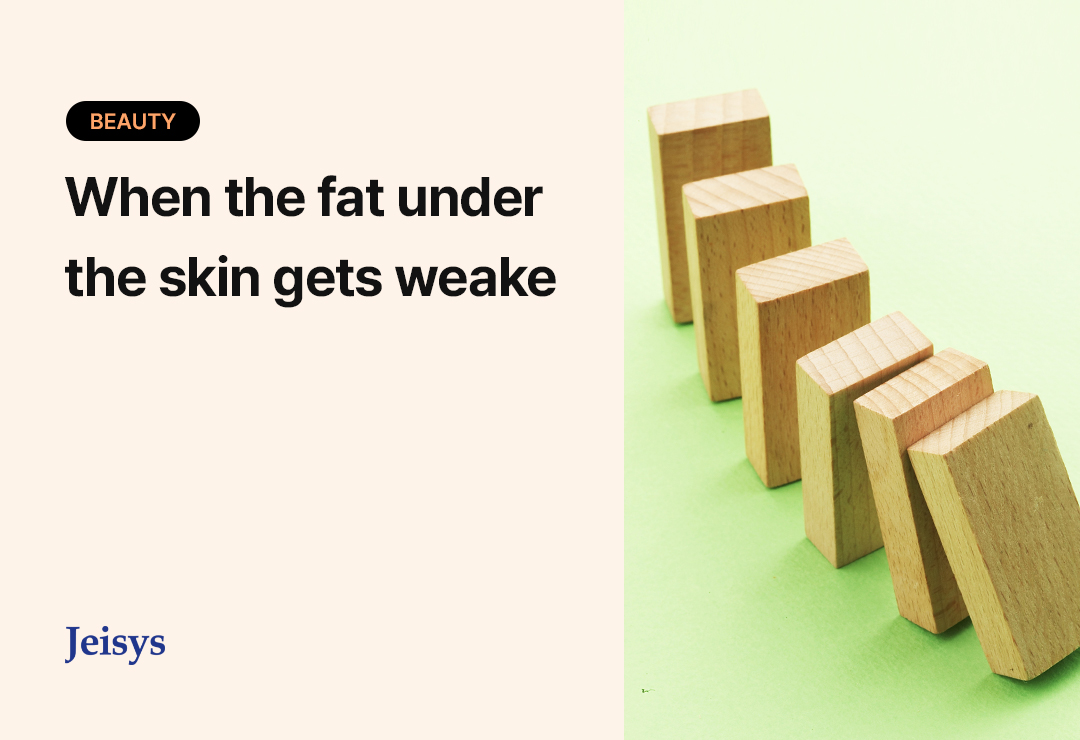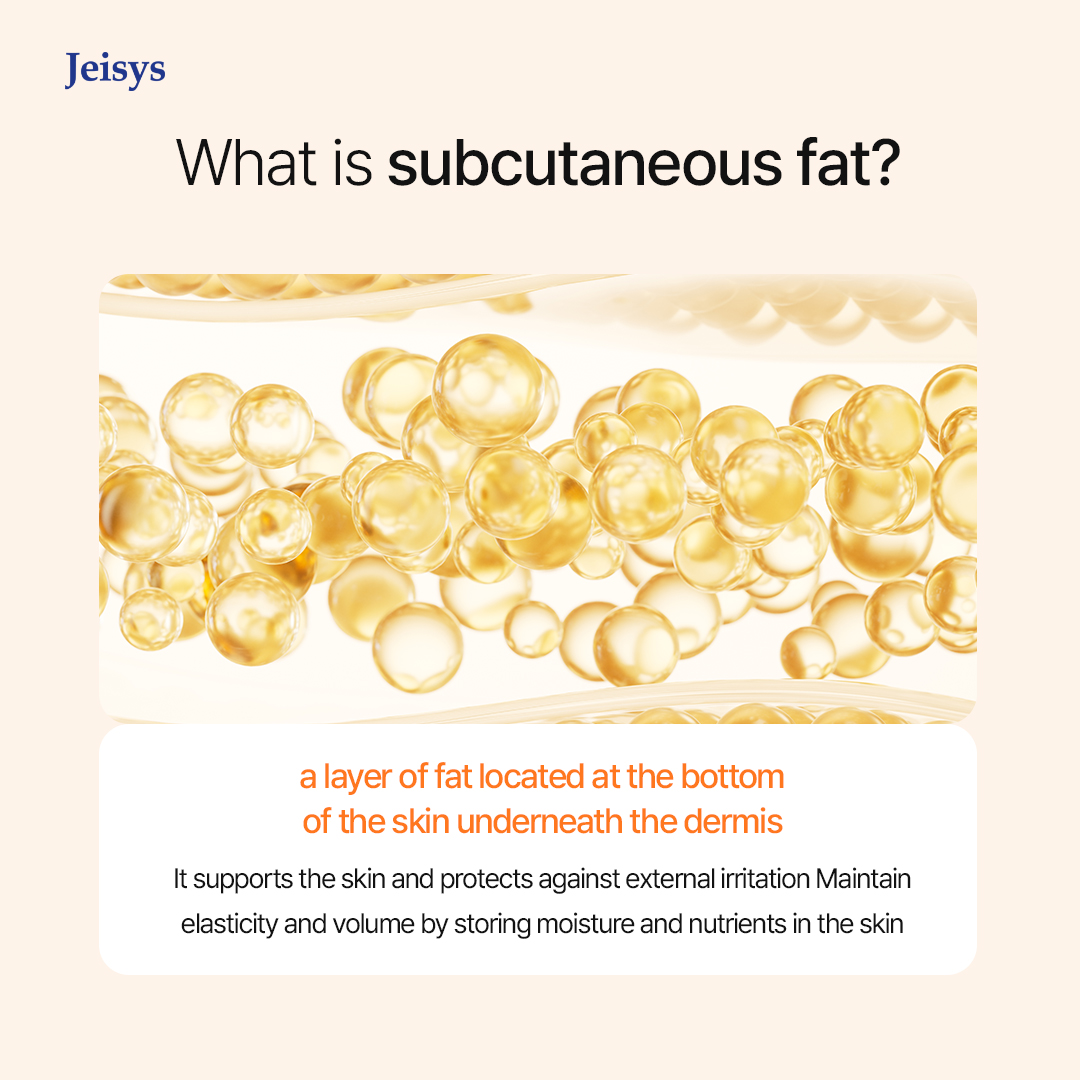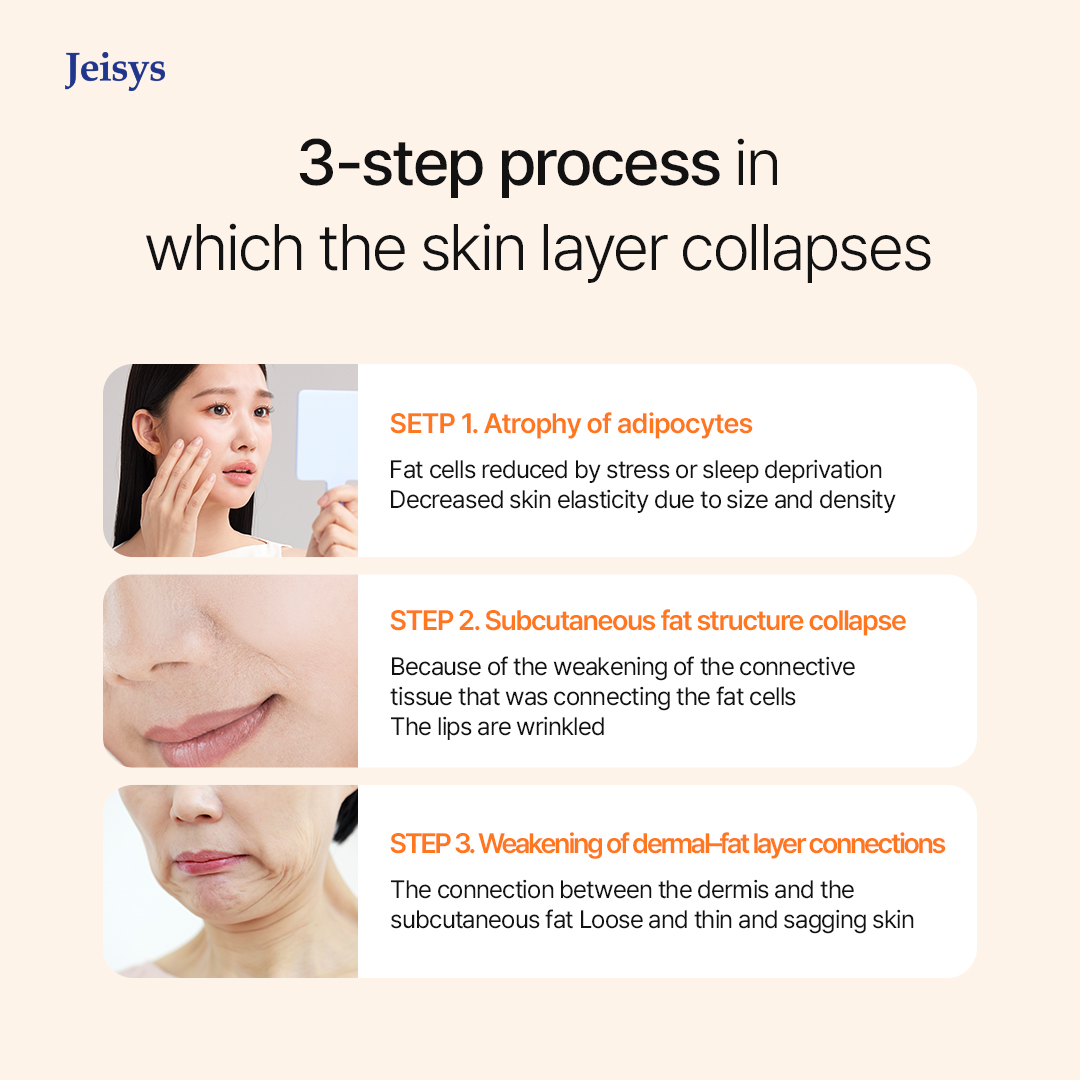Targeting Sagging: Improve Skin Elasticity and Restore Facial Volume as Subcutaneous Fat Decreases.
- Author
- Date
- 2025-11-12
- Views
- 265

When you look in the mirror these days, do you feel like your face looks flatter or your cheek volume has diminished compared to before? The reason may not be entirely due to weight. This change appears when the subcutaneous fat layer deep within the skin thins and the supporting structure beneath it begins to shake.
The youthful impression we commonly seek actually starts with the balance between skin elasticity and subcutaneous fat. Subcutaneous fat acts like a cushion that supports facial volume beneath the dermis. When this subcutaneous fat layer decreases or shifts, the face appears planar, the skin sags, and the loss of skin elasticity gradually progresses.
Therefore, rather than dismissing it as, "I lost cheek fat; maybe I got slimmer?", it is beneficial to check if your subcutaneous fat density and facial volume are decreasing together. In such cases, an **in-depth volume care routine** that looks after the internal skin structure and circulation is needed, rather than just focusing on the surface, right?
The youthful impression we commonly seek actually starts with the balance between skin elasticity and subcutaneous fat. Subcutaneous fat acts like a cushion that supports facial volume beneath the dermis. When this subcutaneous fat layer decreases or shifts, the face appears planar, the skin sags, and the loss of skin elasticity gradually progresses.
Therefore, rather than dismissing it as, "I lost cheek fat; maybe I got slimmer?", it is beneficial to check if your subcutaneous fat density and facial volume are decreasing together. In such cases, an **in-depth volume care routine** that looks after the internal skin structure and circulation is needed, rather than just focusing on the surface, right?
Table of Contents
- Trend 1. What is Subcutaneous Fat?
- Trend 2. The 3-Step Process of Skin Layer Collapse
- Trend 3. Volume Restoration + Skin Elasticity Recovery Strategy

Trend 1. What is Subcutaneous Fat?
Subcutaneous fat refers to the layer of fat located deepest in the skin, beneath the dermis. This layer serves as a support base that holds up the entire face, providing both volume and skin elasticity. It is a cushion layer that softly supports the skin and protects it from external stimuli, acting as a warehouse that stores moisture and nutrients to help maintain elasticity and facial volume.
To draw a parallel, if collagen and elastin are the springs, subcutaneous fat is the mattress placed on top. Just as it's uncomfortable if the mattress sinks even when the springs are bouncy, if the subcutaneous fat thins, the contours easily collapse, and skin elasticity drastically diminishes.
When UV rays, stress, or irregular habits accumulate, this layer gradually thins. This dulls the reflection of light and deepens shadows, giving the face a fatigued and aged impression.
To draw a parallel, if collagen and elastin are the springs, subcutaneous fat is the mattress placed on top. Just as it's uncomfortable if the mattress sinks even when the springs are bouncy, if the subcutaneous fat thins, the contours easily collapse, and skin elasticity drastically diminishes.
When UV rays, stress, or irregular habits accumulate, this layer gradually thins. This dulls the reflection of light and deepens shadows, giving the face a fatigued and aged impression.

Trend 2. The 3-Step Process of Skin Layer Collapse
Changes in subcutaneous fat are often unnoticeable on the surface but progress systematically internally. Let's look at the process in 3 steps.
Step 1. Fat Cell Atrophy
When stress or lack of sleep persists, the size and density of fat cells in our skin decrease. As this internal cushion thins, facial volume in the cheeks or forehead diminishes, and skin elasticity drops, causing the face line to sag heavily.
Step 2. Collapse of Subcutaneous Fat Structure
When the connective tissue holding the fat cells together weakens, the fat shifts to one side or sags downwards. This makes nasolabial folds, perioral lines, and jawline sagging stand out, and the facial volume in the mid-face area noticeably decreases, dramatically changing the overall impression.
Step 3. Weakening of Dermis–Fat Layer Connection
When the connection that holds the dermis and subcutaneous fat loosens, the skin loses supporting power from the surface and stretches. The result is the simultaneous collapse of the balance of wrinkles, elasticity loss, and facial volume.
Q. How does the face change when volume decreases?
1. Aged Facial Contour
The central volume disappears as the cheek fat and under-eye volume decrease, and light is not reflected evenly, making the face look planar and creating a tired impression.
2. Skin Laxity
The internal support system is weakened due to the thinned subcutaneous fat layer, causing the cheekbones and jawline to sag downwards. This is when the loss of skin elasticity becomes noticeable, and many people strongly feel the need for a skin lifting solution.
3. Formation of Wrinkles & Contours
Skin with decreased support creates excess surface area, causing deep folds like nasolabial folds, vertical lip lines, and chin wrinkles to settle.
Step 1. Fat Cell Atrophy
When stress or lack of sleep persists, the size and density of fat cells in our skin decrease. As this internal cushion thins, facial volume in the cheeks or forehead diminishes, and skin elasticity drops, causing the face line to sag heavily.
Step 2. Collapse of Subcutaneous Fat Structure
When the connective tissue holding the fat cells together weakens, the fat shifts to one side or sags downwards. This makes nasolabial folds, perioral lines, and jawline sagging stand out, and the facial volume in the mid-face area noticeably decreases, dramatically changing the overall impression.
Step 3. Weakening of Dermis–Fat Layer Connection
When the connection that holds the dermis and subcutaneous fat loosens, the skin loses supporting power from the surface and stretches. The result is the simultaneous collapse of the balance of wrinkles, elasticity loss, and facial volume.
Q. How does the face change when volume decreases?
1. Aged Facial Contour
The central volume disappears as the cheek fat and under-eye volume decrease, and light is not reflected evenly, making the face look planar and creating a tired impression.
2. Skin Laxity
The internal support system is weakened due to the thinned subcutaneous fat layer, causing the cheekbones and jawline to sag downwards. This is when the loss of skin elasticity becomes noticeable, and many people strongly feel the need for a skin lifting solution.
3. Formation of Wrinkles & Contours
Skin with decreased support creates excess surface area, causing deep folds like nasolabial folds, vertical lip lines, and chin wrinkles to settle.

Trend 3. Volume Restoration + Skin Elasticity Recovery Strategy
Fortunately, there are many ways to restore skin volume. It is also important to remember that the key to effective skin elasticity improvement is the simultaneous restoration of the internal skin structure, facial volume, and skin elasticity.
Internal Skin Volume Reinforcement Routine
Internal Skin Volume Reinforcement Routine
- The Peptide + Collagen Booster combination aids the fat cell–dermis connection, helping to restore supporting power.
- The Hyaluronic Acid complex firmly locks in moisture, boosting the density of the subcutaneous fat layer and the feeling of volume.
- Ceramide & Bakuchiol (Retinol alternative) help synthesize collagen, smoothly strengthening skin elasticity.
Skin Circulation Rhythm Management
- When massaging with your fingertips, gently pull upwards in the sequence of jawline → cheeks → cheekbones → temples to aid skin circulation. At this time, lymph flow improves, revitalizing fat cell function and alleviating puffiness.
- It's best to get deep sleep between 10 PM and 2 AM when skin regeneration is most active. This is the true golden time for skin elasticity.
Professional Procedure Solutions
- Sculptra (PLLA) & Rejuran induce collagen production beneath the dermis, solidifying the subcutaneous fat–skin connection.
- Micro volume fillers can naturally restore facial volume in sunken areas.
- The key after the procedure is maintaining the results for a long time with sunscreen + moisturizing!
TIP Daily Lifestyle Habits
- Drastic dieting is forbidden! When weight is lost suddenly, subcutaneous fat decreases first, which can cause facial volume to drastically sink.
- Drink enough water (1.5~2L per day)! Drinking water often helps activate fat cells and skin tissue, which is essential for maintaining skin elasticity.
- Sunscreen is a must! UV rays negatively affect not only collagen but also subcutaneous fat cells.
Subcutaneous fat is invisible, but it is the hidden protagonist protecting skin elasticity and facial volume. If this layer collapses, the three-dimensional look disappears, the skin sags, and the face easily looks fatigued.
But don't worry. You can fully preserve the density of subcutaneous fat and restore skin elasticity and facial volume with a consistent routine and correct care.
Restoring volume is the secret to looking younger, and the act of making your original curves sparkle again.


